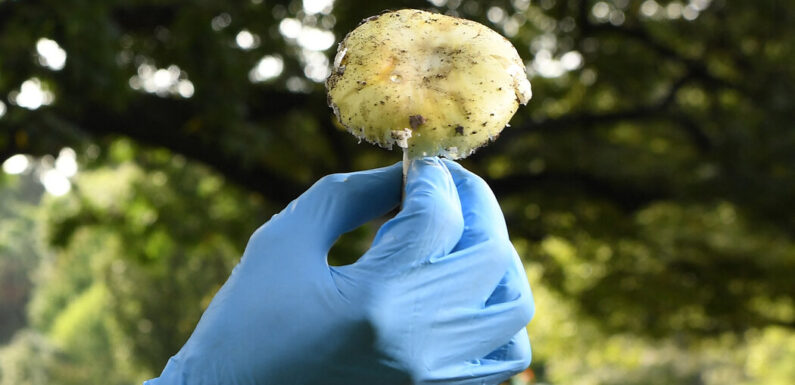
Foragers around the world hunt for wild mushrooms to bring their earthy, nutty, meaty flavors to the table. But every so often, people mistake a potentially lethal variety for the edible ones.
A mushroom called the death cap — Amanita phalloides — and dozens of related species containing the same toxin, alpha amanitin, account for the vast majority of mushroom-poisoning deaths. And many scientists have tried to find a quick remedy.
“There’s no antidote,” said Terrence Delaney, a plant biologist and mycologist at the University of Vermont who studies the toxin profiles of a related mushroom called the destroying angel.
In the past, such poisoning was fatal in more than half of the cases, but today about 85 to 90 percent of people survive. The main treatment is hydration, because the toxin is excreted in urine, Dr. Delaney said, and also includes electrolytes and substances to protect the liver. “But a lot of people don’t get better, and the only effective therapy is a liver transplant,” he said.
Over the years, researchers have proposed and tested several treatments, Dr. Delaney said, adding, “To be honest, none of those are convincing.”
Alpha amanitin wreaks havoc in the body by mucking up the cells’ ability to make messenger RNA. Messenger RNA builds proteins, and without new proteins, the cell’s machinery grinds to a halt. As the toxin circulates in the body, it causes extensive damage to the liver.
But researchers have very little idea of how exactly the toxin does its dirty work, said Qiaoping Wang, a pharmacologist and toxicologist at Sun Yat-Sen University in Shenzhen, China.
Dr. Wang and his colleagues are not foragers themselves. They are, however, in the business of examining the genome to look for chains of biological events set off by toxins, as well as molecules that block them. In a study published on Tuesday in Nature Communication, they reported finding a promising molecule that seemed to prevent some of the toxic effects of alpha amanitin.
The researchers first used CRISPR, the gene-editing technology, to create human cells with thousands of specific genes knocked out, one by one. They then swamped the cells with alpha amanitin and tracked which ones continued to thrive. If the cells’ lives were rosier when a specific gene was deactivated, they reasoned, that gene might be involved in fighting off the toxin. They narrowed in on one gene, STT3B, that seemed especially critical to toxicity.
Next, the researchers used computer modeling to search for compounds approved by the U.S. Food and Drug Administration that might block STT3B, coming up with 34 possible drugs. All but one fell away in further tests on cells.
The remaining compound, called indocyanine green (ICG), is a dye widely used to take images of liver and heart function. When Dr. Wang and his team injected the toxin into mice, followed by ICG, the animals’ recovery improved and the liver damage decreased significantly.
“The exact mechanism is still unknown,” Dr. Wang said. But his team’s work so far suggests that the STTB3 gene somehow helps alpha amanitin enter cells, and that ICG prevents this step.
“It’s a spectacularly cool paper,” said Anne Pringle, a mycologist and geneticist at the University of Wisconsin, Madison, who has studied death caps for 20 years. “They do this amazing amount of work and end with this hypothesis that they’ve found an antidote.”
Whether the compound will work in people remains to be seen, but it’s a good starting point, Dr. Pringle said. “I love that they took it all the way to a mouse model,” she said, “because that’s a lot more than I’ve seen with some of these other ideas that have come and gone.”
The ICG’s effectiveness also depended on the window between the injection of the toxin and the reception of the drug; the possible remedy tapered off if given more than four hours later.
Too often, people don’t know they’ve eaten a toxic mushroom like the death cap until eight or more hours later because they don’t feel sick until then, Dr. Delaney said. After suffering some intense gastrointestinal symptoms, people undergo two to three days in which they feel much better. But all the while, the toxin continues to cause damage.
Dr. Delaney is part of a worldwide network of experts who run a Facebook group called Poison Help; Emergency Identification for Mushrooms & Plants.
People ask the group to identify death caps or related mushrooms. Last year, he recalled, a young boy told relatives that he’d eaten a“marshmallow” he had found in the yard. The family realized what happened, took him to the emergency room, and asked the Facebook group to identify the mushroom. Knowing what it was, doctors provided appropriate care and the boy recovered.
“We are really good at quickly identifying Amanitas and almost always give replies within 15 minutes,” he said.
Antidote or not, Dr. Delaney said, “early knowledge that someone has ingested one of these is absolutely essential.”
Source: Read Full Article